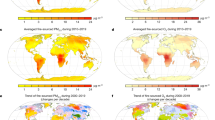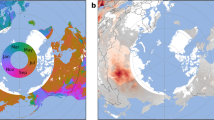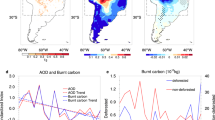Abstract
Emissions from landscape fires affect both climate and air quality1. Here, we combine satellite-derived fire estimates and atmospheric modelling to quantify health effects from fire emissions in southeast Asia from 1997 to 2006. This region has large interannual variability in fire activity owing to coupling between El Niño-induced droughts and anthropogenic land-use change2,3. We show that during strong El Niño years, fires contribute up to 200 μg m−3 and 50 ppb in annual average fine particulate matter (PM2.5) and ozone surface concentrations near fire sources, respectively. This corresponds to a fire contribution of 200 additional days per year that exceed the World Health Organization 50 μg m−3 24-hr PM2.5 interim target4 and an estimated 10,800 (6,800–14,300)-person (∼ 2%) annual increase in regional adult cardiovascular mortality. Our results indicate that reducing regional deforestation and degradation fires would improve public health along with widely established benefits from reducing carbon emissions, preserving biodiversity and maintaining ecosystem services.
This is a preview of subscription content, access via your institution
Access options
Subscribe to this journal
Receive 12 print issues and online access
$209.00 per year
only $17.42 per issue
Buy this article
- Purchase on Springer Link
- Instant access to full article PDF
Prices may be subject to local taxes which are calculated during checkout




Similar content being viewed by others
References
Langmann, B., Duncan, B., Textor, C., Trentmann, J. & Van der Werf, G. R. Vegetation fire emissions and their impact on air pollution and climate. Atmos. Environ. 43, 107–116 (2009).
Field, R. D. & Shen, S. S. P. Predictability of carbon emissions from biomass burning in Indonesia from 1997 to 2006. J. Geophys. Res. 113, G04024 (2008).
Jones, D. S. ASEAN and transboundary haze pollution in Southeast Asia. Asia Eur. J. 4, 431–446 (2006).
World Health Organization. WHO Air Quality Guidelines for Particulate Matter, Ozone, Nitrogen Dioxide and Sulfur Dioxide (World Health Organization, 2006).
Tosca, M. G., Randerson, J. T., Zender, C. S., Flanner, M. G. & Rasch, P. J. Do biomass burning aerosols intensify drought in Equatorial Asia during El Niño? Atmos. Chem. Phys. 10, 3515–3528 (2010).
Heil, A. & Goldammer, J. G. Smoke-haze pollution: A review of the 1997 episode in Southeast Asia. Reg. Environ. Change 2, 24–37 (2001).
Baccini, A. et al. Estimated carbon dioxide emissions from tropical deforestation improved by carbon-density maps. Nature Clim. Change 2, 182–185 (2012).
Van der Werf, G. R. et al. Global fire emissions and the contribution of deforestation, savanna, forest, agricultural, and peat fires (1997–2009). Atmos. Chem. Phys. 10, 11707–11735 (2010).
Pechony, O. & Shindell, D. T. Driving forces of global wildfires over the past millennium and the forthcoming century. Proc. Natl Acad. Sci. USA 107, 19167–19170 (2010).
Johnston, F. H. et al. Estimated global mortality attributable to smoke from landscape fires. Environ. Health Perspect. 120, 695–701 (2012).
Van Der Werf, G. R. et al. Climate regulation of fire emissions and deforestation in equatorial Asia. Proc. Natl. Acad. Sci. USA 105, 20350–20355 (2008).
Wooster, M. J., Perry, G. L. W. & Zoumas, A. Fire, drought and El Niño relationships on Borneo (Southeast Asia)in the pre-MODIS era (1980–2000). Biogeosciences 9, 317–340 (2012).
Siegert, F., Ruecker, G., Hinrichs, A. & Hoffmann, A. A. Increased damage from fires in logged forests during droughts caused by El Niño. Nature 414, 437–440 (2001).
Frankenberg, E., McKee, D. & Thomas, D. Health consequences of forest fires in Indonesia. Demography 42, 109–129 (2005).
Emmanuel, S. C. Impact to lung health of haze from forest fires: The Singapore experience. Respirology 5, 175–182 (2000).
Textor, C. et al. The effect of harmonized emissions on aerosol properties in global models—an AeroCom experiment. Atmos. Chem. Phys. 7, 4489–4501 (2007).
Naeher, L. P. et al. Woodsmoke health effects: A review. Inhal. Toxicol. 19, 67–106 (2007).
Naidoo, R., Malcolm, T. & Tomasek, A. Economic benefits of standing forests in highland areas of Borneo: Quantification and policy impacts. Conserv. Lett. 2, 35–44 (2009).
Collins, M. et al. The impact of global warming on the tropical Pacific Ocean and El Niño. Nature Geosci. 3, 391–397 (2010).
Giglio, L. et al. Assessing variability and long-term trends in burned area by merging multiple satellite fire products. Biogeosciences 7, 1171–1186 (2010).
Bey, I. et al. Global modeling of tropospheric chemistry with assimilated meteorology- Model description and evaluation. J. Geophys. Res. 106, 23073–23095 (2001).
Van Donkelaar, A. et al. Global estimates of ambient fine particulate matter concentrations from satellite-based aerosol optical depth: Development and application. Environ. Health Perspect. 118, 847–855 (2010).
United Nations. World Population Prospects: The 2010 Revision CD-ROM edn (United Nations, 2011).
Pope, C. A. et al. Lung cancer and cardiovascular disease mortality associated with ambient air pollution and cigarette smoke: Shape of the exposure–response relationships. Environ. Health Perspect. 119, 1616–1621 (2011).
Ostro, B. Outdoor air Pollution: Assessing the Environmental Burden of Disease at National and Local Levels Vol. 5 (WHO Environmental Burden of Disease Series, World Health Organization, 2004).
World Health Organization Death Estimates for 2008 by Cause for WHO Member States (2011); available via http://go.nature.com/2pcb7c.
Center for International Earth Science Information Network (CIESIN) and Centro Internacional de Agricultura Tropical (CIAT) Gridded Population of the World Version 3 (GPWv3): Population Grids (SEDAC, 2005); available at http://sedac.ciesin.columbia.edu/gpw.
Center for International Earth Science Information Network (CIESIN), United Nations Food and Agriculture Programme (FAO) and Centro Internacional de Agricultura Tropical (CIAT). Gridded Population of the World: Future Estimates, 2015 (GPWv3): Population Grids (SEDAC, 2005); available at http://sedac.ciesin.columbia.edu/gpw.
Bell, M. L., Dominici, F. & Samet, J. M. A meta-analysis of time-series studies of ozone and mortality with comparison to the national morbidity, mortality, and air pollution study. Epidemiology 16, 436–445 (2005).
Acknowledgements
We are grateful to P. Kasibhatla for his help with the GEOS-Chem model runs. We also thank the local staff at B. K. Tabang and T. Rata for the WDCGG O3 data, M. Brauer for the annual PM2.5 data and K. Wolter at NOAA for the El Niño index. This work was supported by a National Sciences Foundation graduate research fellowship and NASA award NNX11AF96G. GFED3 is publicly available at http://www.globalfiredata.org.
Author information
Authors and Affiliations
Contributions
R.S.D., A.V. and M.E.M. designed the study. G.F., A.V. and M.E.M. conducted the model runs; R.S.D., A.V., J.T.R., D.T.S., Y.C. and M.E.M. contributed to the model analysis; P.L.K. and M.E.M. conducted the health estimates. All authors contributed to the writing of the manuscript.
Corresponding authors
Ethics declarations
Competing interests
The authors declare no competing financial interests.
Supplementary information
Supplementary Information
Supplementary Information (PDF 1384 kb)
Rights and permissions
About this article
Cite this article
Marlier, M., DeFries, R., Voulgarakis, A. et al. El Niño and health risks from landscape fire emissions in southeast Asia. Nature Clim Change 3, 131–136 (2013). https://doi.org/10.1038/nclimate1658
Received:
Accepted:
Published:
Issue Date:
DOI: https://doi.org/10.1038/nclimate1658
This article is cited by
-
A global dataset for the production and usage of cereal residues in the period 1997–2021
Scientific Data (2023)
-
Fire regime of peatlands in the Angolan Highlands
Environmental Monitoring and Assessment (2023)
-
Carbon dioxide and particulate emissions from the 2013 Tasmanian firestorm: implications for Australian carbon accounting
Carbon Balance and Management (2022)
-
Estimation of hospital visits for respiratory diseases attributable to PM10 from vegetation fire smoke and health impacts of regulatory intervention in Upper Northern Thailand
Scientific Reports (2022)
-
A systematized review exploring the map of publications on the health impacts of drought
Natural Hazards (2022)



